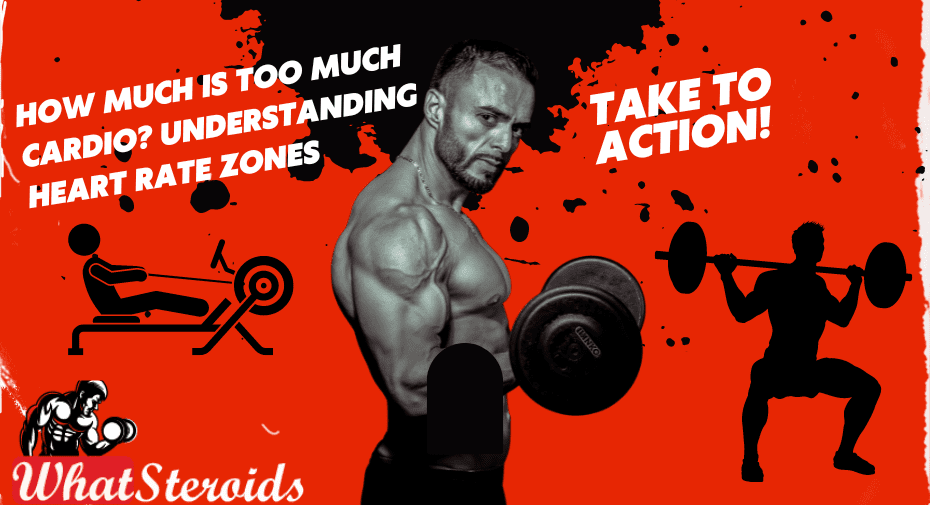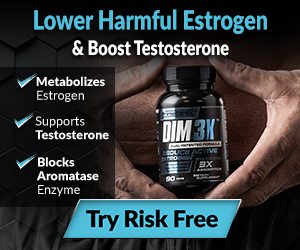How Much Is Too Much Cardio? Understanding Heart Rate Zones


The relationship between cardio and heart rate zones for bodybuilders revolves around optimizing cardiovascular health, improving metabolic efficiency, and supporting overall conditioning while minimizing interference with muscle growth and strength development.
By strategically incorporating cardio workouts within different heart rate zones, bodybuilders can achieve a balanced approach to fitness that enhances both cardiovascular performance and muscular development, ultimately leading to a well-rounded and resilient physique.
Related Article: Emotional Effects of Steroids
Heart rate zones are ranges that indicate different levels of exercise intensity based on your maximum heart rate. Here’s a guide to understanding heart rate zones:
Zone 1 (50-60% of max HR)
This is a very comfortable effort used for warm-ups.
Zone 2 (60-70% of max HR)
This is considered a fat-burning zone. It’s a comfortable effort used for endurance training.
Zone 3 (70-80% of max HR)
This zone improves aerobic capacity and endurance.
Zone 4 (80-90% of max HR)
This zone increases anaerobic capacity and threshold.
Zone 5 (90-100% of max HR)
This is the maximum effort zone, improving speed and power.
Your maximum heart rate is roughly calculated as ( 220 - \text{your age} ). For example, if you’re 30 years old, your estimated maximum heart rate would be ( 220 - 30 = 190 ) beats per minute (bpm).
Remember, these figures are averages and can vary based on individual fitness levels, health status, and other factors.
These Gear Could Help Monitor Your Heart Rate
For bodybuilders and athletes looking to monitor their heart rate, there are several types of heart rate monitors that can be suitable:
Chest Strap Monitors
These provide the most accurate readings and are ideal for continuous monitoring during workouts. The Polar H10 and Garmin HRM-Pro Plus are highly recommended.
Armband Monitors
These are comfortable for longer workouts and are less constricting than chest straps. The MyZone MZ-Switch and Wahoo Fitness Tickr Fit are popular choices.
Wristband Monitors
These are less accurate than chest straps but are more convenient for all-day wear. The Fitbit Versa 4 and Google Pixel Watch are options that also offer additional fitness tracking features.
Each type has its pros and cons, so it’s important to choose one that fits your specific needs and comfort preferences.
It’s also worth noting that while wristband monitors are more convenient, they may not always provide the accuracy required for intense bodybuilding workouts where precision is key.
Always ensure that the device you choose is compatible with any other fitness tracking systems you use.
Cardio Do's and Don'ts
To avoid focusing too much on cardio and neglecting heart rate zones, we recommend these tips:
- Set clear goals: Define your fitness objectives, whether it's building muscle, improving endurance, or enhancing overall health. This will help you prioritize your training methods accordingly.
- Consult a fitness professional: Work with a personal trainer or exercise physiologist who can assess your individual needs and create a balanced workout plan tailored to your goals.
- Incorporate resistance training: Include strength training exercises in your routine to build muscle mass and improve strength. This can help you maintain a healthy balance between cardio and strength training.
- Monitor intensity: Pay attention to how your body feels during workouts and adjust the intensity accordingly. Utilize heart rate monitors or perceived exertion scales to ensure you're staying within your desired heart rate zones when doing cardio.
- Schedule cardio strategically: Plan your cardio sessions around your strength training workouts to avoid overemphasizing cardio. Consider incorporating high-intensity interval training (HIIT) or shorter, more intense cardio sessions to maximize efficiency.
- Prioritize recovery: Allow adequate time for rest and recovery between workouts to prevent burnout and overtraining. Recovery is essential for muscle growth and overall performance.
- Track progress: Keep track of your workouts and progress over time to ensure you're making balanced improvements in both cardiovascular fitness and strength.
Appropriate Diet for Each Zone
When it comes to diet for bodybuilders focusing on different heart rate zones, it's important to prioritize overall nutritional balance and meeting specific training goals rather than tailoring the diet solely based on heart rate zones. However, here's a general list of dietary recommendations for bodybuilders, including 10 supplements that can support their training:
| Protein: Essential for muscle repair and growth. Sources include lean meats, poultry, fish, eggs, dairy, tofu, legumes, and protein supplements like whey protein powder.
Carbohydrates: Provide energy for workouts and replenish glycogen stores. Opt for complex carbohydrates such as whole grains, fruits, vegetables, and legumes. Vegetables and Fruits: Rich in vitamins, minerals, and antioxidants for overall health and recovery. Aim for a variety of colorful fruits and vegetables to ensure a wide range of nutrients. |
Don't Miss: Anabolic Steroids Less Likely to Cause Acne
| Hydration: Stay well-hydrated to support performance and recovery. Drink plenty of water throughout the day, especially before, during, and after workouts.
Creatine: Helps increase muscle strength and power output during high-intensity exercise. Can be consumed through supplementation or found naturally in small amounts in meat and fish. Branched-Chain Amino Acids (BCAAs): Support muscle recovery and growth. Can be consumed through supplements or found in protein-rich foods like meat, dairy, and legumes. Beta-Alanine: Helps increase muscle endurance by buffering lactic acid buildup. Commonly found in pre-workout supplements or consumed separately. Glutamine: Supports immune function and muscle recovery. Can be taken as a supplement or found naturally in protein-rich foods like meat, dairy, and legumes. Omega-3 Fatty Acids: Have anti-inflammatory properties and support overall health. Found in fatty fish like salmon, as well as in fish oil supplements. |
It's important for new bodybuilders to focus on establishing a well-rounded diet that meets their energy needs and provides adequate nutrients to support their training and recovery.
Always consult with a healthcare professional or registered dietitian before starting any new supplement regimen to ensure safety and effectiveness, especially if you have any underlying health conditions or concerns.
Take Away
The question of "how much cardio is too much?" is one that requires a nuanced understanding of individual fitness goals, training intensity, and overall health status. By delving into the concept of heart rate zones, we can gain valuable insights into optimizing cardiovascular training while avoiding potential pitfalls of excessive cardio. Understanding the different heart rate zones, including the aerobic, anaerobic, and maximal zones, allows individuals to tailor their workouts to specific objectives, whether it's improving endurance, increasing aerobic capacity, or enhancing fat burning.
However, it's essential to recognize that more isn't always better when it comes to cardio training. Overdoing cardio can lead to diminishing returns, increased risk of injury, and potential negative impacts on muscle growth and strength development, especially for bodybuilders and other athletes focused on resistance training. Therefore, striking a balance between cardiovascular exercise and strength training is crucial for achieving well-rounded fitness and performance goals.
Moreover, the optimal amount of cardio varies greatly among individuals and depends on factors such as fitness level, training experience, age, and overall health status. It's essential to listen to your body, pay attention to signs of overtraining, and adjust your workout routine accordingly. Consulting with a fitness professional or healthcare provider can provide valuable guidance in determining the appropriate amount and intensity of cardio for your specific needs and goals.
Ultimately, finding the right balance between cardio and strength training, understanding your heart rate zones, and respecting your body's limits are key to achieving sustainable progress and maintaining long-term health and fitness. By approaching cardio training with mindfulness and moderation, individuals can harness its benefits while minimizing potential drawbacks, leading to a well-rounded and effective fitness regimen tailored to individual needs and aspirations.
Must Read: Best Steroid Cycles for Beginners
Recent Posts
Decoding IGF-1 LR3: A Guide to its Benefits
IGF-1 LR3 (Insulin-like Growth Factor-1 Long Arg3) is a synthetic variant of IGF-1, a hormone…
AOD-9604: The Fat-Burning Peptide Explained
AOD-9604, along with the similar HGH Frag 176-191, is a peptide derived from Growth Hormone…
Understanding Trenbolone-Induced Cough (“Tren Cough”)
Trenbolone, a potent anabolic steroid, can sometimes cause “tren cough”—a sudden and intense coughing episode…
Creatine vs Myostatin: An Expert’s Analysis
Myostatin, a protein encoded by the MSTN gene, acts as a regulator of muscle growth.…
Raloxifene (Evista) 101: A Non-Surgical Solution for Gyno
Raloxifene, a selective estrogen receptor modulator (SERM), is one of the most valuable yet less…
Mastering Bodybuilding in 2025: Top Fitness Tips for Success
Bodybuilding is more than just a sport; it's a lifestyle that requires dedication, discipline, and…



